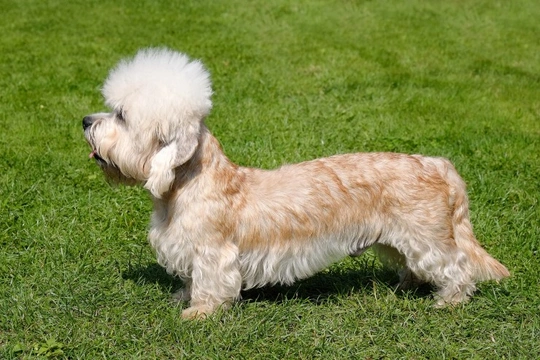
Cushing’s disease in the Dandie Dinmont terrier dog breed
The Dandie Dinmont terrier is a small and not very common dog of the terrier type, which is distinctive thanks to its long body and short legs, and signature pompom of fur on the top of the head.
The breed is one of our homegrown native dog breeds, originating from the Scottish borders, where the Dandie Dinmont was originally bred and developed as a working dog breed that has a superior ability to hunt small prey, having the conformation to be able to go to earth and follow pests into setts and burrows.
Dogs of the breed have a strong prey drive, are very tenacious, and have bags of endurance, as well as a distinctive stubborn streak. Owning a Dandie Dinmont terrier is well suited to people who have a good understanding of the core terrier traits, and that are able to tailor the dog’s care and training to match.
If you are looking to buy a small dog of the terrier type that is lively but not overly onerous on the exercise front and that is middle of the road in terms of their ease to train and manage, the Dandie Dinmont is a breed worth considering. However, it is also important to review a general picture of the average health and longevity of dogs of any breed before you come to a decision.
Like many pedigree dog breeds, the Dandie Dinmont terrier has elevated risk factors for a few hereditary health conditions, and one of these is Cushing’s disease.
In this article we will explain why the Dandie Dinmont terrier dog breed has elevated risk factors for Cushing’s disease, as well as outlining how the condition affects dogs, and how to buy a healthy Dandie Dinmont puppy. Read on to learn more about Cushing’s disease in the Dandie Dinmont terrier.
What is Cushing’s disease?
Cushing’s disease is also sometimes known as hyperadrenocorticism, and this is a type of hormonal disorder that generally develops in affected dogs later in life.
Cushing’s disease can be either spontaneous, in which the condition develops on its own without being influenced by any external factors, or it can be acquired as a result of the long-term use of certain types of medications, most commonly certain types of steroids designed to treat other health problems.
The Dandie Dinmont terrier breed as a whole has higher than normal risk factors for spontaneous Cushing’s disease, and this is considered to be a hereditary defect that can be found within certain breed lines.
Dogs with Cushing’s disease produce too much cortisol – a type of natural steroidal hormone – within their adrenal glands, which causes the dog’s body to generate a stress response even when not placed under any stress.
Spontaneous Cushing’s disease can result from tumours of the dog’s pituitary gland, and this is the root cause of the condition in the vast majority of cases. However, the condition can also be caused by a problem with the adrenal glands, although this is much less common.
Why is the Dandie Dinmont terrier at higher risk of developing Cushing’s disease?
The Dandie Dinmont terrier dog breed is one across which only a relatively small number of dogs of the breed can be found, which means that the size of the breed’s gene pool of unrelated breeding stock is very limited.
This means that a hereditary health problem can spread within the breed faster and with greater ease than would be the case in larger breed populations, and such problems can quickly become established within the breed.
Once this occurs, the condition stands a chance of becoming prevalent if steps are not taken to curb its spread, and this means that Dandie Dinmont breeders need to select their mating matches with care to ensure that a predisposition to Cushing’s disease within the breed is not passed onto their own litters.
How can Cushing’s disease be predicted or identified?
Currently, there is no DNA testing protocol in place to identify the markers of or indicators for Cushing’s disease within breeding stock. Diagnosing the condition relies upon physical examination of the dog in question, as well a running a range of tests to confirm if there are any problems with the dog’s hormone levels and general health.
In dogs with the condition, changes and anomalies in their blood chemistry indicate the presence or development of the condition. However, the risk factors for any given dog cannot be determined in advance with DNA testing or any other screening protocol, and the exact mode of heredity for Cushing’s disease in the Dandie Dinmont terrier is not yet known.
Buying a healthy Dandie Dinmont puppy
If you are considering buying a Dandie Dinmont puppy, you may well find that it takes some time to find a breeder, and you may need to travel quite far to see a litter. However, even if you have your heart set on buying a pup, you should still be speculative about the health and wellness of the breed line and not rush into a purchase.
Ask the breeder of the litter you are considering if either their dam or sire had Cushing’s disease, or if it is present within any of the litter’s other close relatives.
Whilst one relative with Cushing’s disease does not automatically indicate that a related litter’s pups will also develop the condition, it can provide some pointers and enable you to weigh up the pros and cons of any purchase.



